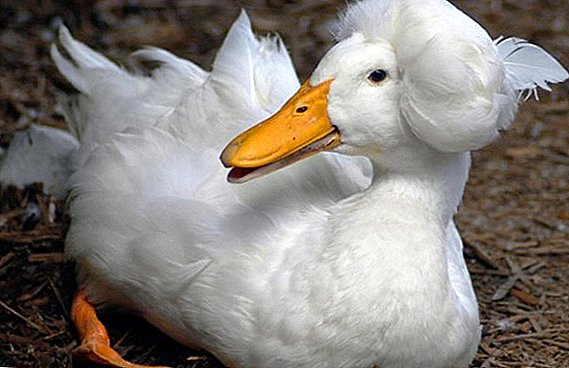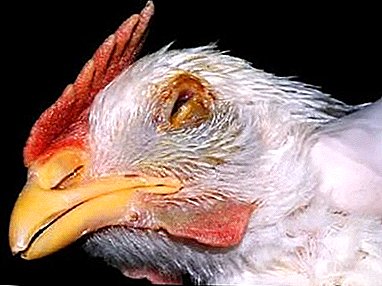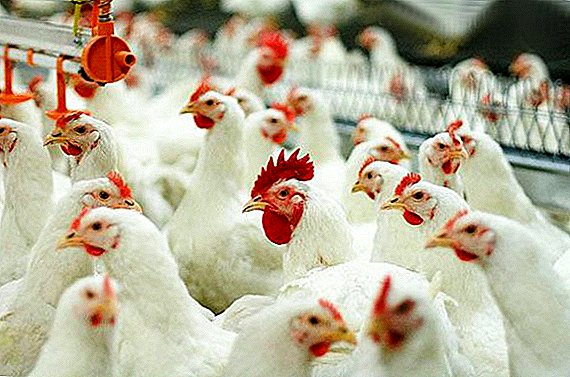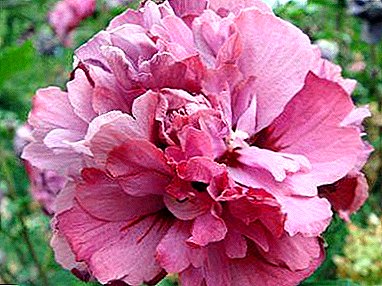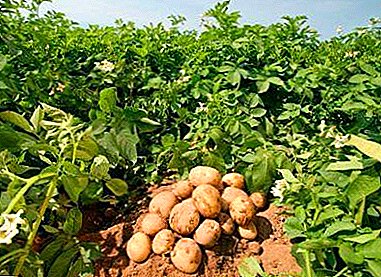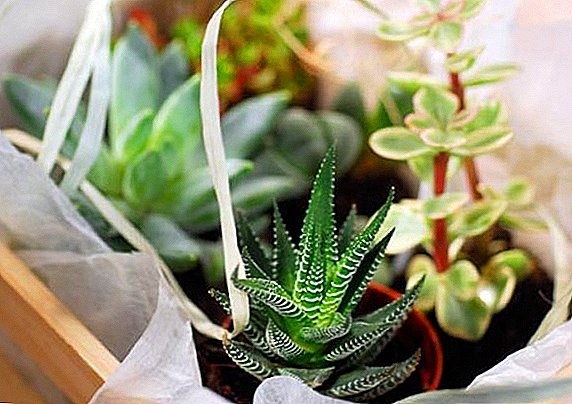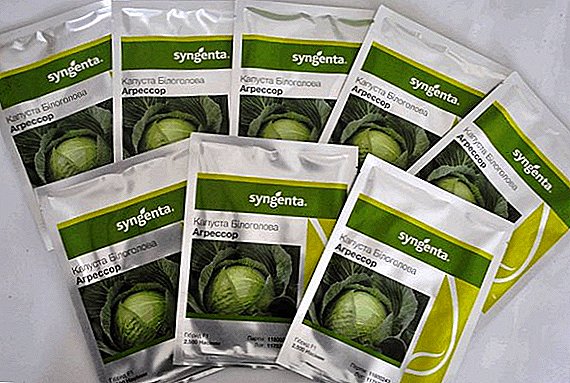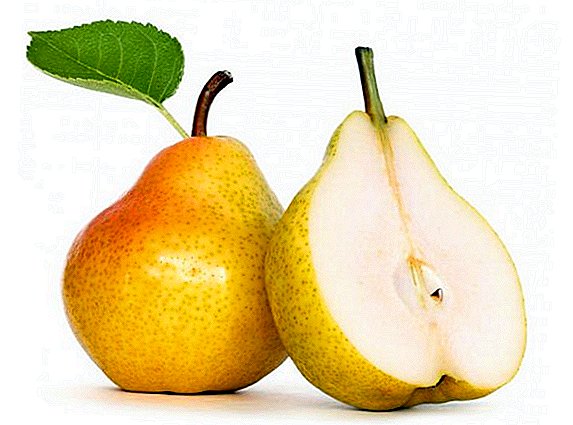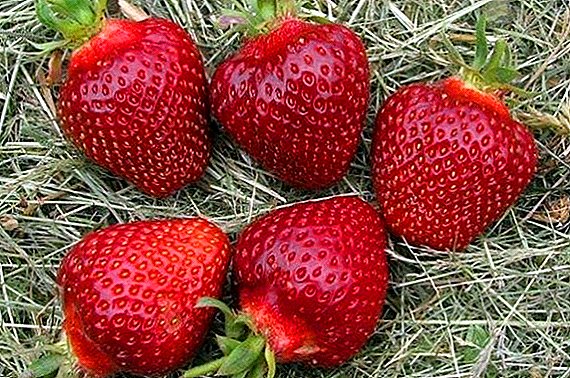 Fans grow their own strawberries thoughtfully relate to its wide range, not losing sight of information about all sorts of new products.
Fans grow their own strawberries thoughtfully relate to its wide range, not losing sight of information about all sorts of new products.
Strawberry "Black Prince", and now we will deal with the description of this particular variety, is rapidly gaining popularity among summer residents and other land users - therefore, we would like to pay more attention to it. In the beginning - a bit of terminology.
Description
Under the "strawberry" experts understand the bisexual plant with a poor yield of small dark red (with the appearance of whiteness) tasty berries, which grows mainly in shaded areas of uncultured nature - rarely "invite" to civilized gardens and vegetable gardens because of weak fruiting and small berries.
What is grown in cottages and in household plots, including the “Black Prince”, is entirely home-grown garden strawberry varieties, one of which is offered to you.
Did you know? This strawberry (we will still use the common name) was called the "Black Prince" by the Italians from the New Fruit Company who received this variety in the city of Cesena for the rich burgundy color of fruits that appear black in the shade or at a distance.
The main characteristics of the plant are as follows:
- Large, densely leafy bushes with an average number of thick mustaches.
- Medium-sized dark green leaves with a predominance of gloss and a small grid of wrinkles.
- Magnificent underground (root) part.
- Good adaptability to sub-zero temperatures and disease resistance.
- Large (up to 50 g) conical, very tasty berries (without internal voids).
- The average early and high (up to 30 tons per hectare since the second year) yields, which further only grows.

Features and differences from other varieties
In addition to the most eye-catching features (the same and the difference) in the form of the size of the fruit, it is worth highlighting, perhaps, the following:
- bushes in growth exceed all other varieties of strawberries;
- annually increasing fruiting period;
- perennial (up to 7 years and above) growing does not reduce the yield and size of the fruit, but reduces the number of thickened whiskers;
- the height of straight shoots, in combination with the top arrangement of ripe berries, provides ease of harvesting;
- uniformity, in size, berries, facilitating their sorting;
- increased, in the sense of the magnitude of the distances and long-preserving marketable fruit, portability.
I would like to talk only about the merits, but for objectivity it should be mentioned that:
- a small number of whiskers limits the size of the planting material;
- "Black Prince" does not tolerate drought;
- the root system is prone to rapid decay on heavy soils - even sensible drainage does not save (and does not contribute to a good plant survival);
- It is easily attacked by a transparent strawberry mite, and in the autumn period it can fall ill with spotting.

Landing
General pre-planting requirements are as follows:
- The place should be open to the sun and closed from the air flow from the north.
- The presence of groundwater is not allowed higher than 0.6 m from the ground (and to guarantee against root rot, it is better that their level is below the specified limit).
- To accommodate the "Black Prince" are not recommended areas in the lowlands and on the slopes (a slight slope of the surface does not count).
- Gray forest soils, light loams and sandy loams are preferred. Invalid clay, peat, silt. Chernozem requires the addition of sand.
- Of the previous crops are good cereals, legumes, carrots and onions. Eggplants, cabbage, potatoes, tomatoes are not suitable. It is possible to enrich the soil with microelements by preliminary planting of siderats.
- In terms of acidity, the soil must be either neutral or below the average level — dolomite flour (0.3 kg per 1 sq. M) is used to normalize it.
- During the preparatory period (20-30 days before planting), the soil is fertilized with rotted manure (5 liters per 1 sq. M) or with humus, and from it, when digging, any crop residues are removed.
Landing dates may depend on climatic conditions. In temperate climates, they prefer to do this in early fall.
Where there is a significant summer heat, planting is carried out in April-May. The layout is quite sparse (due to a significant increase in green mass) - 40 x 50 cm.
Operational actions look like this.:
- Pour holes with water, 0.5 liters each.
- Spreading the roots of seedlings.
- Actually landing, at which the heart will be slightly higher (up to 2 cm) soil level.
- Soil compaction (around each plant) and first watering.
- Straw mulching with freshly cut grass after water absorption.
Breeding
There are three ways of breeding the "Black Prince":
- Planting seeds.
- Usa.
- The division of the bush.

Seeds
Strawberry seeds are planted, as a rule, by experienced gardeners, whose qualifications are beyond doubt.
This process is complicated, requires thoroughness and patience. It is suitable for those summer residents who strive to truly master the art of land use - the best way to build skills in this business is difficult to offer.
Important! Do not be lazy to study the list of seed producers - having bought seed in bags from popular brands, you can count on a good result without undue anxiety.
If you still have little experience, it is advisable to pre-soak the seeds in a solution of "Epin" (it is possible on cotton pads - for speedy spitting).
But you can still, after self-confident masters, immediately plant them in a prepared soil mixture (equally leafy humus, garden soil and river sand), in which they are made, with 5 cm intervals, shallow (half a centimeter) grooves. When seeds are planted in the wet grooves, sprinkle them on top with a thin earth layer.
The next 1.5-2 weeks will not require much effort: after you place the landing container covered with glass in the room, you need to do regular moistening, by pouring water into the pan, and airing, for which you will need to clean the glass for a while.
After this period, the seeds begin to rise, and you move them closer to the sun.
The content of the next two steps consists in seating the seedlings at different distances, the magnitude of which is signaled by the emerging leaves:
- with the advent of the first intervals between plants are made by 2-3 cm;
- with a foliage of 4-5 copies, the intervals increase to 5 cm.
Important! It is recommended that the tips of the roots be slightly shorter when they are first placed. - it will speed up the growth process.
If the described option seemed too cumbersome to you, then simplify it by planting seeds in peat tablets (there are special cavities for this) - then you just have to do that you can add some water to the pan, since the tablets themselves are sources of nutrition.  We draw your attention to another significant circumstance - before the strawberry transplantation itself into open space, you need to temper it a little, “educated” at home, placing it first near the open breathing window with April air and then moving it onto the balcony, consistently increasing the procedure time (starting at quarter past an hour).
We draw your attention to another significant circumstance - before the strawberry transplantation itself into open space, you need to temper it a little, “educated” at home, placing it first near the open breathing window with April air and then moving it onto the balcony, consistently increasing the procedure time (starting at quarter past an hour).
Usa
As already mentioned, the landing material in the form of a mustache in the "Black Prince" is not rich. Moreover, this and so a small number is produced only in the first three years of the plant’s life.
But the simplicity of the method still constantly attracts gardeners to its use.
There is a sequence of such steps:
- Denoting for yourself, as a result of a thorough examination, the presence of a mustache on a bush with young rosettes, you can separate those who are more successful in their development.
- By connecting sockets to pots with a primer (plastic or peat), you do a lot of watering.
- About a fortnight later, when the socket was sufficiently rooted, and the mustache was fully fed with the necessary substances, you cut off the socket, interrupting its supply, and plant it in a new area, again providing abundant watering.
 The rapid intensive growth of strawberries planted in this way will not be long in coming.
The rapid intensive growth of strawberries planted in this way will not be long in coming.Care
It would be great if the strawberries in the beds grow by themselves, and we would approach it only at the time of picking berries. Do not indulge in dreams - you need to go to the rules of care for the "Black Prince".
Watering
Every day it needs to be watered during the post-planting and flowering period.
When the terms of fruiting come, the situation will change - now it is necessary to spend 1-2 deciliters of water per square meter of land only, watering the bushes once a week.
Important! Excessive watering at this time will add wateriness to the berries - they will become unsuitable for food and storage.
Irrigation methods use different (sprinkling, podkorennoy irrigation), but the best is considered to saturate the soil with moisture through filling dug between the rows of grooves.  The best are also:
The best are also:
- water of 20-degree temperature (use a dacha tank heated by sunlight);
- evening time for the irrigation procedure itself;
- post-irrigation loosening of the soil so that the roots are not left without air due to the formation of an impermeable crust;
- mulching beds - for water retention, then you will not often have to loosen the soil.
Top dressing
General rules for feeding strawberries:
- The use of two types of feeding - root (watering) and foliar (sprinkling and spraying).
- Lack of chlorine in the top dressing.
- Neat (without water on the growth points) watering the bushes for half an hour before feeding.
- For leaf spraying, the treatment of their lower parts is especially important, through which nutrients are absorbed.
By time feeding is distributed as follows:
- Early spring (before the growing season) - ammonium nitrate or urea (up to 20 g / decaliter) in any way.
- The formation of buds and the beginning of flowering is superphosphate (40 g per sq. M) in a foliar way.
- Fruit ripening - mineral complex fertilizers ("Agricola", "Berry" according to the instructions).
 For those who dislike chemical components, it is recommended to use an infused aqueous solution (1 to 4) of bird droppings infused in the sun for a week, which is further diluted before use in a ratio of 1:10, the same foliage-stem solution of nettle (1: 2 ), daily filtered infusion of wood ash (50 g / l) - the last tool replaces potash and phosphate fertilizers.
For those who dislike chemical components, it is recommended to use an infused aqueous solution (1 to 4) of bird droppings infused in the sun for a week, which is further diluted before use in a ratio of 1:10, the same foliage-stem solution of nettle (1: 2 ), daily filtered infusion of wood ash (50 g / l) - the last tool replaces potash and phosphate fertilizers.Post-harvest care
Harvest "Black Prince" is collected in the mornings, after drying dew. Intervals between charges - 3 days.
Important! Do not clean after rain, and then get the limp berries that neither eat nor save.
But harvesting care for the "royal offspring" is not limited. Moreover, it is precisely now that special attention must be paid to the “Black Prince” in order to preserve the entire shrub and create a foundation for an excellent harvest in the next season.
Here is what you need to do:
- Remove the previous mulch; then carefully so that no leaf is left, weed the soil.
- Spud the plants and enrich the soil (require vermicompost or humus).
- Break through the aisle.
- To carry out post-harvest watering (one and a half liters of water per bush).
 As for irrigation, one thing is not limited to: taking into account the weather (if the precipitation is not thick), it is necessary to continue them, doing one or two weekly, and to prevent from diseases, the beds are also watered with a weakly concentrated solution of manganese (twice, not more).
As for irrigation, one thing is not limited to: taking into account the weather (if the precipitation is not thick), it is necessary to continue them, doing one or two weekly, and to prevent from diseases, the beds are also watered with a weakly concentrated solution of manganese (twice, not more).
As part of the care of the bushes themselves, it is necessary to remove the whiskers that appear, without touching the green foliage - the basis of the future abundant green mass. Also check that the root system is completely underground.
After collecting the berries, additional fertilizing with a complex of minerals is also carried out, but without nitrogen, as it was during the ripening of the fruits.
It will be necessary to finish the season already in the late autumn, having covered the beds with strawberries with a spice (pine) or spunbond, so that the heat retained in this way does not allow the roots to freeze in winter.
Did you know? Strawberry (strawberry) berries in Russia as soon as they called - Polovnitsa, grublyanka, sunitsa, Victoria (for the famous French variety), but the correct way - garden strawberries.

Diseases and pests
In addition to the above-mentioned strawberry mite and white-brown spot, this variety of strawberry is susceptible to verticillus and aphid invasion.
The manifestations of each of these misfortunes must be fought differently:
- They rescue a tick by treating plants with karbofos (it can be colloidal sulfur), spreading 8 grams of the substance in 10 liters of water. If the lesion has reached a large size, then the dosage is increased by 15%.
- The spotting is removed using Antracol or Ridomyl Gold (dosage, respectively, 15 and 25 g per 10 l). It can be avoided due to prophylactic treatment (2-3 times) with Bordeaux liquid.
- Verticillosis is treated only in the case of an insignificant lesion, 0.2% “Fundazol” (10 g per 10 l) is used, in other cases, diseased plants are destroyed. Prevention consists in dipping the root system with “Agat 25K” or “Potassium HUMATE” (7 and 15 g per 10 l) before disembarking.
 Finally, I lick, while it's not enough, they just take it away with their hands.
Finally, I lick, while it's not enough, they just take it away with their hands.If the invasion is massive, then sprayed with one of two compositions of the solution:
- garlic - per dal of water 0.2 l of garlic juice, the same onion and 0.15 l - dandelion;
- soapy 6% m - 60 g / l.
A certain hassle in connection with the cultivation of the "Black Prince" is present. But painfully good then the result! So don't be lazy - get both fragrant sweetness and peace of mind, and if you risk entering the market, you will also get substantial profits.


